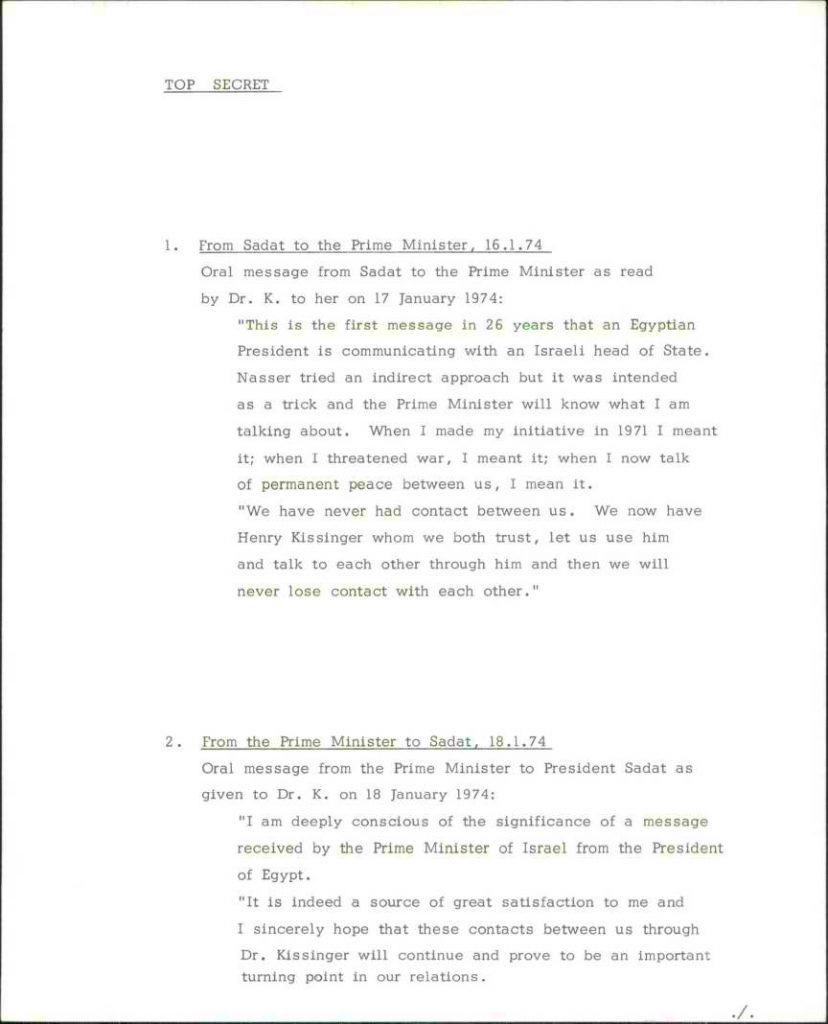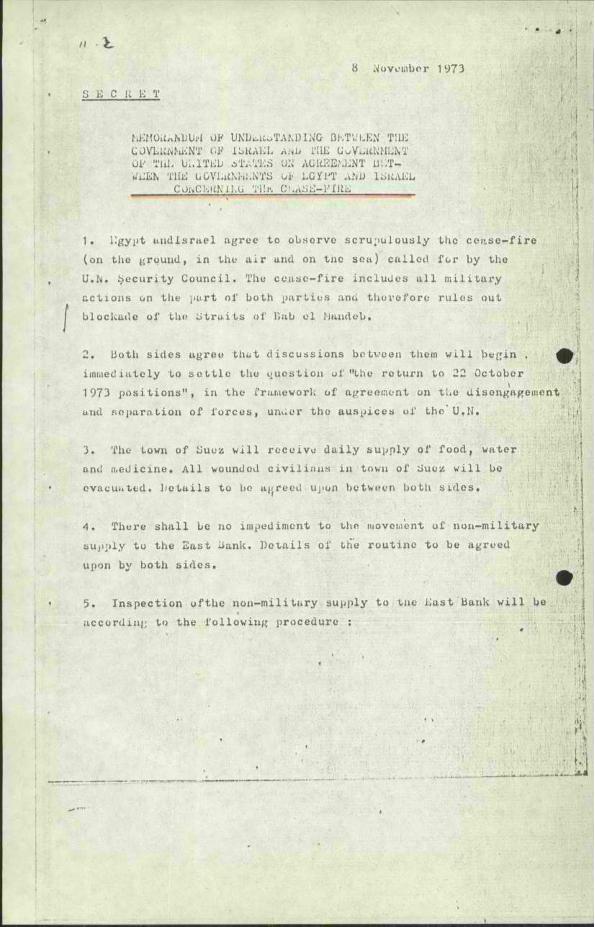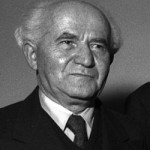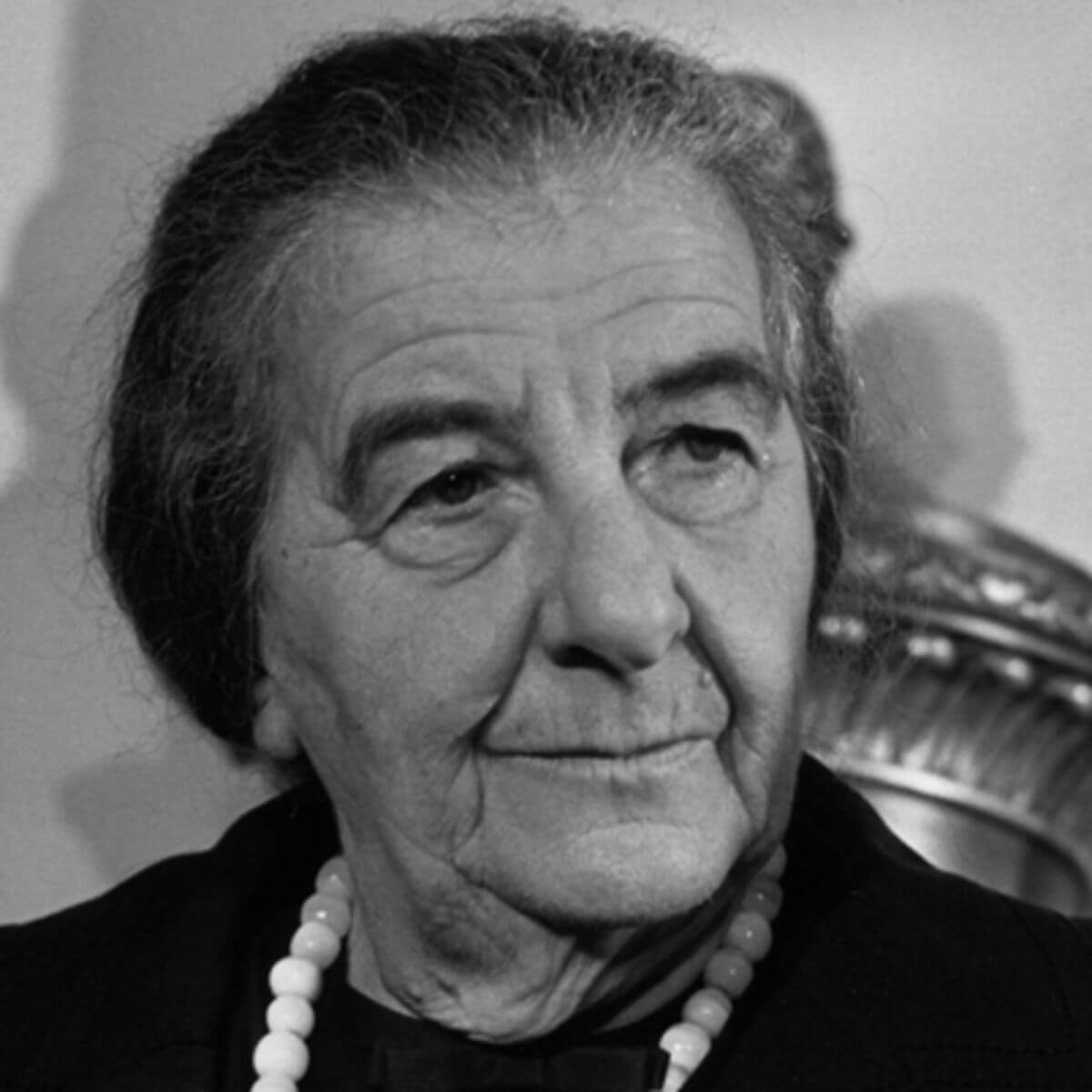א.1 | The Exchange of Messages with Anwar Sadat, January 1974

Sadat’s message to Golda Meir and the first part of her reply, ISA, File A 7063/7
“When I made my [political] initiative in 1971, I meant it; when I threatened war, I meant it; when I now talk of permanent peace between us, I mean it.” This was the message from President Anwar Sadat given to Israeli Prime Minister Golda Meir by US Secretary of State Henry Kissinger shortly before the signing of the Separation of Forces (Disengagement) Agreement between Israel and Egypt (Sinai I) on January 18, 1974.
The next day Golda Meir replied that she hoped that their contact through Kissinger would prove to be a turning point in their relations, and repeated Sadat’s words: “When I talk of permanent peace between us I mean it.” Only three months after the Yom Kippur War, when they had led their countries in a bloody and costly conflict, the two leaders exchanged messages expressing goodwill and the desire for peace between them.
Defense Minister Moshe Dayan was the first person to propose a separation of forces in a government meeting on October 27, 1973. The war had just ended, but sporadic firing continued and continued to cause casualties. The smoke still lingered on the battlefields. A grieving Israel was anxious for a ceasefire, the return of the prisoners of war and a solution to the problem of the missing, the return of the reservists to their homes and an end to the costly mobilization. The government also hoped for a political solution, which would allow the IDF to withdraw from its dangerously overextended lines on the western bank of the Suez Canal and avoid a war of attrition.
Dayan therefore proposed to bring to the discussions that were about to begin with the Egyptians at the 101st kilometre mark on the Suez-Cairo highway, a proposal for a framework for a separation agreement between the two armies – Israel to the east of the canal and Egypt to the west of it, with a demilitarized separation zone of equal size on both sides between them. Prime Minister Meir accepted his proposal and expressed the hope that it would be the beginning of negotiations on a political settlement that would ultimately lead to peace between Israel and Egypt. The government approved the proposal and it was brought before the Egyptians. Their initial reaction was that they were willing to consider the idea, but proposed a different outline – separation of forces that would be based on the withdrawal of the IDF from the west bank of the Suez Canal up to the Gidi and Mitla passes inside Sinai. Symbolic Egyptian forces would remain on the eastern side, UN forces would be stationed between the armies and then peace negotiations would begin.
For the records of the 101st KM talks, see Files MFA-5203/9, MFA-5203/10, MFA-5204/2, A 7554/4

First page of the Six Point Agreement, 8.11.1973. ISA, File A 7078/1.
In the weeks that followed, the proposal for separation of forces took shape in various forums, including Prime Minister Meir’s talks in Washington, the 101st km talks, Kissinger’s visit to the region in mid-December 1973, the Geneva Conference, and especially Kissinger’s “shuttle” trip to Israel and Egypt in January 1974. During the contacts, an initial agreement was signed on November 12, 1973 at the 101st KM, the “6-point agreement” between Israel and Egypt, in which the framework for the discussions was set. The agreement also set conditions for the exchange of prisoners and the continuation of supplies to the Egyptian Third Army (to view the full text, File A-7078/1). The talks continued, but Kissinger was interested in taking over their sponsorship, as he sought to take advantage of the military situation to promote wider diplomatic steps and to push the Soviets out of the Middle East. At his request, the direct talks were halted and transferred to the Geneva conference. At the beginning of January 1974, Moshe Dayan arrived in Washington to continue the negotiations. On 11 January Kissinger arrived to wrap them up and to bring about the signing of the ageement.
Since Sadat wanted to reach an agreement with Israel quickly, before the Arab world and the Soviets could organize opposition, Kissinger was able to reach a text agreed upon by both sides – a historic agreement in which Israel agreed for the first time to withdraw from territory it captured in the Six Day War. (See the records of the talks in File MFA-5255/1). Israel agreed that a token Egyptian force would be stationed on the eastern side of the Suez Canal and the IDF would withdraw to a line some 25 kilometres further east of the Canal. At Egypt’s request, limitations on forces and types of weapons were proposed to both sides in a letter from President Nixon. Due to doubts about Sadat’s credibility, it was decided that the United States would monitor the limitation of forces through American photographic flights. Sadat’s personal message to Golda Meir was also intended to convince the Israeli side that that Egypt had decided to adopt a policy of negotiations instead of war.

First page of the record of the meeting with Kissinger, 15.1.1974. File MFA 5255/1
On 15 January Kissinger met with Dayan, Deputy Prime Minister Yigal Allon and Foreign Minister Abba Eban, without Golda Meir who was ill, and presented the latest Egyptian proposal. Afterwards a government meeting was held at the home of the prime minister, and she recommended that the proposal be accepted. It would prevent another war on the part of Egypt to end Israel’s presence on its territory, and it was better to end the war in a dignified manner , she said. Kissinger went to Aswan in Egypt and received the Egyptians’ agreement to the proposal. On 17 January he returned to Jerusalem and the following day, as snow carpeted the city and made travel alsmot impossible, he finalized the final details with Dayan, Allon and Eban. That same day, President Nixon announced at the White House that Israel and Egypt had reached an agreement. The agreement was accompanied by Sadat’s political commitments to the Americans to open the Suez Canal and allow the passage of cargoes to Israel through the Bab El-Mandeb straits, which were blocked by Egypt during the war. These commitments were passed on to Israel in the form of a secret Memorandum of Understanding. (To view the Memorandum of Understanding , File A 7078/1)
On January 18, 1974, Chief of Staff David Elazar and the commander of the Egyptian army, General Muhammad Abdel Rani Al-Gamasy, signed the agreement, which effectively brought to an end the Yom Kippur War on the Egyptian front. Although the agreement emphasized the military elements of the separation of forces , it concluded by saying that it should be seen as a first step towards a permanent, just and sustainable peace agreement (to view the text of the signed agreement, File A-7078/1). Soon afterwards the Israeli withdrawal began.

Chief of Staff David Elazar addressing the Israeli press after the signing of the Separation of Forces Agreement, 18.1.1974. Photograph: Ya’acov Sa’ar, Government Press Office

IDF troops preparing to withdraw from positions near Ismailiya, 4.2.1974. ISA Press Photograph Collection, TS 3010/466




